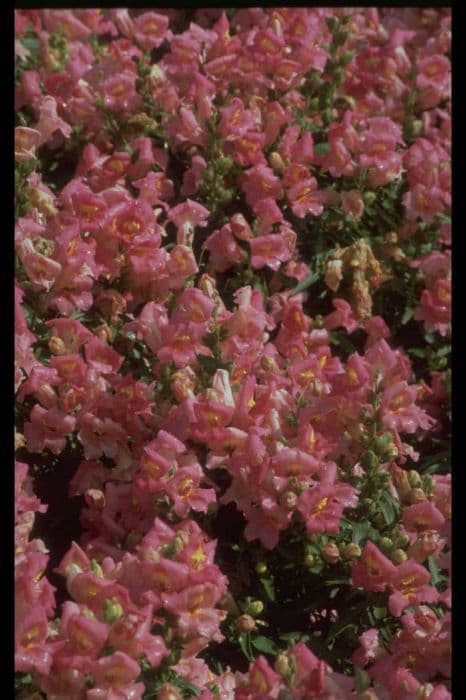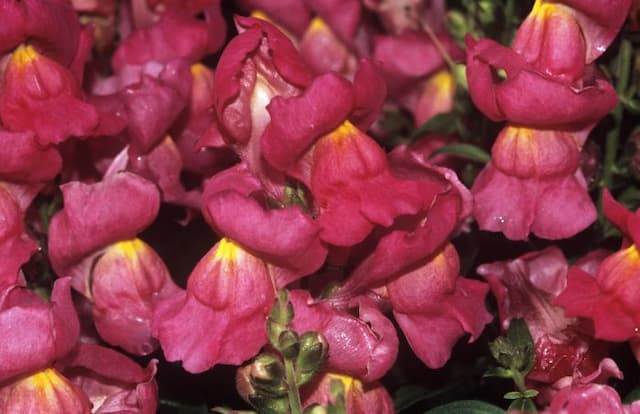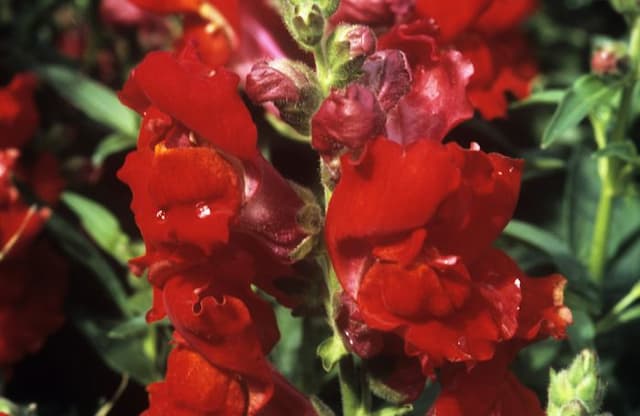Beardtongue Penstemon 'Burgundy'

ABOUT
Penstemon 'Burgundy' is a captivating perennial that features a striking blend of foliage and blooms. Its leaves have a lance-shaped appearance and are arranged neatly along the stem, exhibiting a rich green color that can sometimes carry tinges of purple, especially under the right light conditions or during cooler times of the year. As suggested by the cultivar name 'Burgundy', this Penstemon stands out with its beautiful flowers that have a deep, burgundy hue. The blossoms of Penstemon 'Burgundy' are tubular, reminiscent of small bells or trumpets, which gracefully hang in clusters along the stem, giving the plant a lush, full look. The flowers have a slightly inflated appearance, with a broad opening that narrows towards the connection with the stem. The throat of the flowers often displays lighter coloration, sometimes showcasing streaks or spots that can attract pollinators. These elegant blooms are arranged in dense panicles or racemes and are known for their rich color and attraction to hummingbirds and bees. Penstemon 'Burgundy' has a neat, clumping growth habit, forming an attractive mound of both flowers and foliage. The contrast between the dark, burgundy flowers and the green to purplish leaves creates a stunning display ideal for adding a splash of deep color to garden borders, beds, or as part of a naturalized landscape. Its overall appearance exudes a sense of elegance and drama, making it a favorite for gardeners looking to enhance their outdoor spaces with vibrant, perennial color.
About this plant
 Names
NamesFamily
Plantaginaceae
Synonyms
Beardtongue, Burgundy Beardtongue
Common names
Penstemon 'Burgundy'
 Toxicity
ToxicityTo humans
Beardtongue, including the Penstemon 'Burgundy' variety, is generally considered non-toxic to humans. There are no widespread reports or documented cases of poisoning from consuming or touching this plant. Therefore, accidental ingestion is unlikely to cause harm beyond the possibility of mild stomach discomfort as with any non-food plant material, but as with all plants, individual reactions can vary.
To pets
Beardtongue, also known in the Penstemon 'Burgundy' variety, is typically non-toxic to pets, including dogs and cats. Ingestion of this plant is not known to cause serious harm or toxic effects. While it is always best to prevent pets from consuming non-food plants to avoid potential gastrointestinal upset, the Beardtongue is not considered a significant risk for poisoning in pets.
 Characteristics
CharacteristicsLife cycle
Perennials
Foliage type
Deciduous
Color of leaves
Green
Flower color
Burgundy
Height
2-3 feet (60-90 cm)
Spread
1-2 feet (30-60 cm)
Plant type
Herb
Hardiness zones
3-8
Native area
North America
Benefits
 General Benefits
General Benefits- Attracts Pollinators: Provides food for bees, butterflies, and hummingbirds, enhancing pollination in gardens.
- Drought Tolerant: Once established, it requires minimal watering, making it suitable for xeriscaping or drought-prone areas.
- Low Maintenance: Requires little care beyond occasional pruning and deadheading, making it ideal for busy gardeners or those seeking low-maintenance landscapes.
- Colorful Blooms: Produces rich burgundy flowers that add a vibrant splash of color to garden beds and borders.
- Cold Hardy: Capable of withstanding colder temperatures, which makes it suitable for a variety of climates.
- Long Blooming: Flowers for a prolonged period from late spring to early fall, providing long-lasting visual interest.
- Wildlife Shelter: Provides cover and nesting opportunities for small wildlife and beneficial insects.
- Soil Adaptable: Grows in a wide range of soil types, from well-drained sandy soils to heavier clay, making it versatile for different garden settings.
- Non-Invasive: Unlike some perennials, it remains contained within its planting area, reducing the need for constant management.
- Decorative Seed Heads: After blooming, it produces seed heads that add texture and interest to the winter garden landscape.
 Medical Properties
Medical PropertiesThis plant is not used for medical purposes.
 Air-purifying Qualities
Air-purifying QualitiesThis plant is not specifically known for air purifying qualities.
 Other Uses
Other Uses- Hummingbird Attractor: Penstemon Burgundy’s trumpet-shaped flowers are excellent for attracting hummingbirds to your garden, providing a natural source of entertainment and pollination.
- Photography Prop: Due to its vibrant burgundy-colored blooms, the Penstemon Burgundy can be used as a striking background or subject in garden photography.
- Educational Tool: This plant can be utilized in educational settings, such as biology classes, to illustrate pollination and plant growth processes.
- Drought Tolerance Example: The Penstemon Burgundy, known for its ability to withstand dry conditions, can be used in demonstrations of drought-tolerant landscaping techniques.
- Insect Habitat: The plant can offer a natural habitat to beneficial insects, such as bees and butterflies, contributing to the overall health of the garden ecosystem.
- Erosion Control: When planted on slopes or areas prone to erosion, Penstemon Burgundy’s root system can help stabilize soil and prevent degradation.
- Artistic Inspiration: The rich color and form of Penstemon Burgundy can inspire artists and be used as a live model for drawing, painting, and other forms of artistic creation.
- Culinary Garnish: Although not commonly known for its culinary uses, the flowers can be used as a colorful garnish for fancy dishes in upscale dining.
- Therapeutic Horticulture: The act of growing and caring for Penstemon Burgundy can provide therapeutic benefits for individuals involved in gardening therapy programs.
- Seasonal Decor: The plant’s striking foliage and flowers can be incorporated into autumnal decorations due to its deep, warm tones that match fall color schemes.
Interesting Facts
 Feng Shui
Feng ShuiThe Beardtongue plant is not used in Feng Shui practice.
 Zodiac Sign Compitability
Zodiac Sign CompitabilityThe Beardtongue plant is not used in astrology practice.
 Plant Symbolism
Plant Symbolism- Resilience: Penstemons, including the 'Burgundy' variety, typically thrive in rough conditions and poor soil which symbolizes enduring through hardships.
- Diversity: With over 250 species in the genus, penstemons represent variety and adaptability to various environments.
- Beauty in Simplicity: 'Burgundy' penstemons have an understated elegance with their simple tubular flowers and deep red hues, suggesting the beauty found in simple, natural forms.
- Attraction: Their vivid colors and rich burgundy tones are known to attract hummingbirds and butterflies, symbolizing allure and magnetism.
- Balance: The balance between the plant's ruggedness and its delicate blooms can represent the harmony between strength and beauty.
 Water
WaterBeardtongues, including the Penstemon 'Burgundy', require regular watering, especially during dry and hot spells, to maintain moist but well-drained soil. Water the plant deeply once a week, providing about 1 inch of water each time, which is roughly equivalent to 0.6 gallons for a medium-sized plant. During extreme heat, increase the frequency to every 3 to 4 days but be cautious not to overwater as this can lead to root rot. In cooler weather or during the rainy season, reduce watering to prevent soggy soil conditions. Always check the top inch of soil for dryness before watering to gauge whether the plant needs more moisture.
 Light
LightThe Beardtongue thrives in full sun to partial shade with at least 6 hours of sunlight per day. It is best placed in a spot where it can receive morning sunlight and some afternoon shade, especially in hotter regions, to protect from intense heat. Avoid deep shade as it will inhibit the flowering and can lead to leggy growth.
 Temperature
TemperatureBeardtongues prefer a temperate climate and can generally withstand temperatures ranging from around 20°F to 85°F. Freezing temperatures below 20°F may damage the plant, while prolonged exposure to heat above 85°F can stress it. The ideal temperature range for Penstemon 'Burgundy' is between 60°F and 75°F, where it can flourish and produce its burgundy blooms.
 Pruning
PruningPrune the Beardtongue to remove spent flower spikes after blooming to encourage a second flush of flowers and to maintain a neat appearance. Pruning is typically done in the late fall or early spring. Deadheading, or the removal of spent flowers during the blooming season, promotes continued blooming. If the plant becomes woody or overgrown, cut it back by about one-third to rejuvenate growth.
 Cleaning
CleaningAs needed
 Soil
SoilThe Beardtongue prefers well-draining soil with a slight acidic to neutral pH, typically between 6.0 and 7.0. A mix containing loam, sand, and compost works well to provide the necessary drainage and nutrients.
 Repotting
RepottingThe Beardtongue does not need frequent repotting; it is usually sufficient to repot every 2-3 years to refresh the soil and address the plant's growth.
 Humidity & Misting
Humidity & MistingBeardtongue thrives in average humidity levels similar to those found in outdoor environments, without the need for extra humidity.
 Suitable locations
Suitable locationsIndoor
Place Beardtongue in bright light, avoiding soggy soil.
Outdoor
Plant in sunny spot with well-drained soil.
Hardiness zone
3-8 USDA
 Life cycle
Life cycleThe Beardtongue 'Burgundy' begins its life cycle when seeds are sown in well-draining soil and germinate, typically in the spring. Seedlings emerge and establish a root system, and juvenile plants gradually mature over a few weeks, developing stems, leaves, and the characteristic tubular flowers. Flowering occurs in late spring to early summer, attracting pollinators such as bees and hummingbirds, which assist in the plant's reproduction by transferring pollen. After pollination, the flowers develop into small capsules containing seeds, marking the plant's reproductive stage. As summer wanes, the plant begins to enter dormancy, with foliage dying back in anticipation of winter. The Beardtongue 'Burgundy' completes its life cycle yearly unless it is a perennial variety, in which case it may enter a period of dormancy before resuming growth the following spring.
 Propogation
PropogationPropogation time
Spring to early summer
For the Penstemon 'Burgundy', also known as Beardtongue, propagation is most successfully performed in spring or early summer. One of the most popular methods is by taking stem cuttings. To propagate by cuttings, a gardener should select a healthy, non-flowering stem and cut a piece about 4 to 6 inches long, ensuring there are several nodes on the cutting. The bottom leaves are removed, and the cut end is dipped in rooting hormone to encourage root development. The prepared cutting is then placed in a pot filled with a mix of peat and perlite or a well-draining potting mix. It should be kept in a warm, well-lit place but out of direct sunlight, and the soil should be kept consistently moist but not waterlogged. Roots typically develop within a few weeks, after which the new plant can be gradually acclimated to outdoor conditions before planting in the garden.









